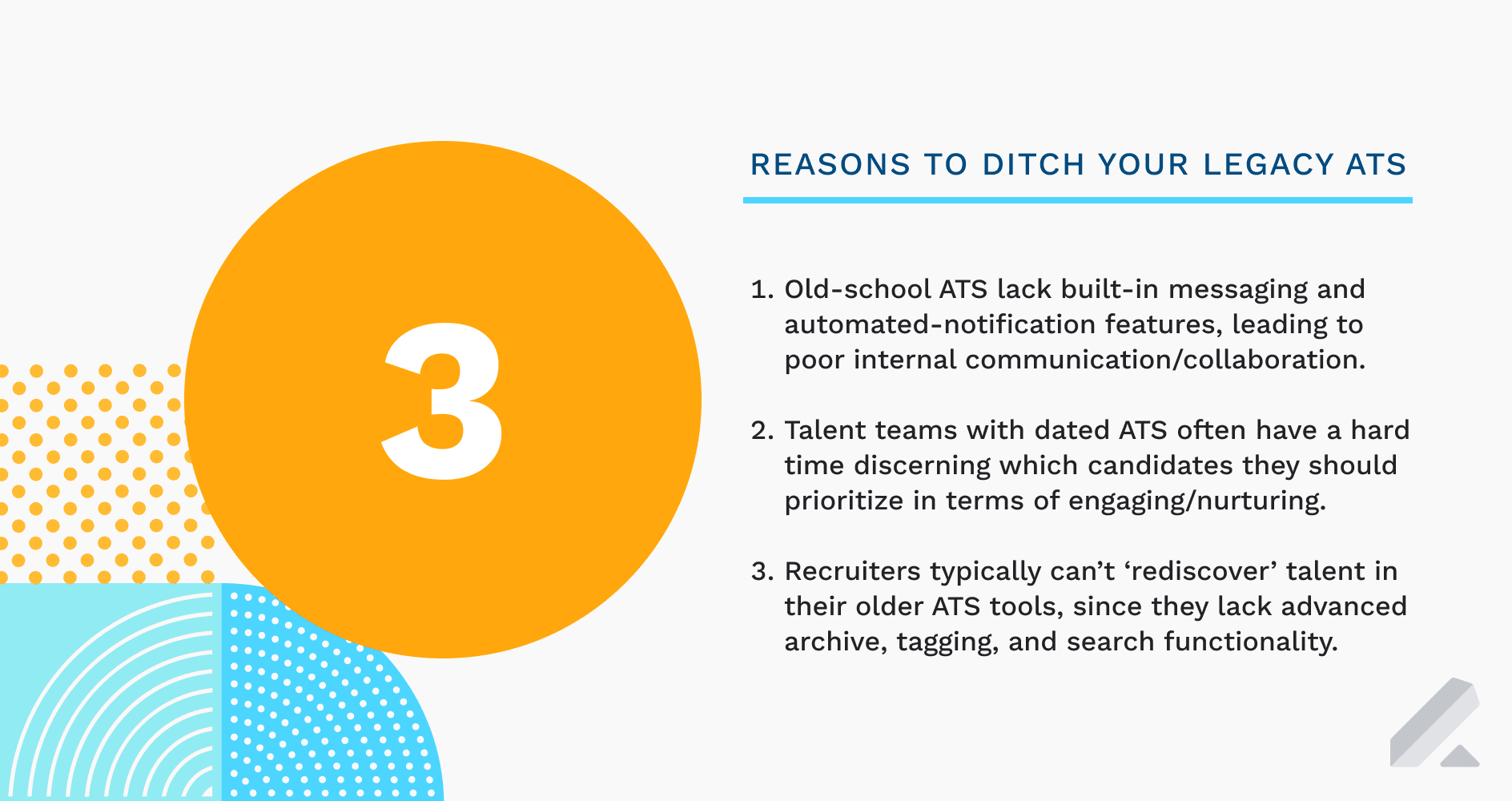Legacy ATS systems no longer get the job done for recruiters and talent specialists.
That means these professionals need to ditch dated applicant tracking systems in favor of more ‘complete’ TA tech that enables them to develop more proactive recruiting processes that help them build relationships with prospects and convert highly qualified talent.
When 71% of talent leaders say candidate relationship management (CRM) functionality is essential in any ATS system in which they invest, it’s clear older, inadequate versions (i.e., ones that lead to inefficiencies and poor hiring) must be eliminated from their TA tech stacks.
The biggest barrier that prevents talent leaders from making the switch to a more advanced ATS? A desire to stick with the status quo (and, in turn, avoid having to manage change).
The truth, however, is there are too many reasons not to transition from old-school ATS systems to more intuitive and effective recruiting software that offers standard ATS features and CRM capabilities.
How legacy ATS systems deter efficiency and productivity for today’s talent acquisition teams
The point of having an applicant tracking system is to use it as the central system of record for candidate information as well as the primary solution in which the entire TA and recruiting org works.
But legacy ATS systems aren’t (and, based on how they’re built, can’t be) single sources of truth for talent teams. Because of this, these teams must integrate their ATS with third-party tools to handle key tasks (e.g., sourcing, nurturing, data analysis), which leads to issues like these.

Poor communication and collaboration among recruiters and hiring managers
Talent pros and hiring teams must work closely with one another during the interview process.
Communicating mainly (or, worse, solely) through tools outside their ATS of choice regarding the status of both job openings (i.e., progress with open reqs) and job seekers (i.e., where specific prospects are in the recruiting funnel) often leads to missed opportunities, redundant work, and — worst of all — a bad candidate experience.
In short, many outmoded applicant tracking systems lack built-in messaging features that allow everyone involved in the hiring process to stay in concert during the full-cycle recruiting cycle.
Moreover, they lack direct integrations with tools like Slack that can automatically update stakeholders when actions are taken by them (e.g., offer extended/accepted) or candidates (e.g., interview self-scheduled) or actions need to be taken (e.g., reminder to leave interview feedback).
Difficulties discerning which job applicants and sourced candidates to prioritize
Aside from working more cohesively within the recruiting function and across teams, legacy ATS makes it hard for TA specialists to determine which candidates they should engage and nurture.
In other words? Their ATS system doesn’t have any machine learning/artificial intelligence baked in that helps talent pros create a strong organizational system that ‘puts’ the perfect candidates — and only the perfect candidates — in front of them for review daily.
This precludes recruiters from automating their talent-review and -management process. What’s more, because they have to manually sort through candidates, the chances of missing out on hiring a prospect because they found another job increases considerably.
An inability to ‘rediscover’ and reach out to talent for active and upcoming roles
A top reason companies have historically invested in ATS systems is because it acts as their … well … historical database for candidates. But older ATS don’t offer easy-to-use filtering and tagging functionality (e.g., based on one’s work experience, certifications, location).
The lack of functionality that enables TA pros to label and search for existing candidates in their respective talent repositories quickly and efficiently hinders their ability to find individuals who may be good fits for open or future roles and reach out to them accordingly.
“Companies spend an inordinate amount of time luring people into the recruitment funnel to get them into a pipeline,” CIO Sr. Writer Sharon Florentine stated. “[B]ut with traditional [ATS] systems, candidates are shelved and forgotten about once a role is filled.”

Why talent orgs all over are turning to TA tech with ATS functionality and CRM capabilities
All these cons pertaining to their existing ATS systems have led many talent leaders to discover the pros of more modern solutions. Some of the key benefits of unified TA suites — and reasons why these leaders are now turning to them — include the ability to:
- Create job descriptions and post to job boards from one place: Listing jobs online, both internally (owned job site/career page) and externally (social media, relevant communities), is no longer arduous or time-consuming for recruiters with a modern ATS. Job postings can be published to several digital locales, all with a few simple clicks.
- Parse resumes and review the most qualified talent of interest: Lever’s algorithm, for instance, ensures only candidates deemed worthwhile (based on pre-defined ‘rules’ created by our customers) get in front of recruiters. Once they have a narrowed-down list of prospects, they can expedite resume parsing through Fast Resume Review. This accelerates screening and makes it easy to advance or archive talent.
- Nurture candidates and track engagement at a granular level: We’ve covered why intelligent, automated email-nurture campaigns are important. What’s equally imperative, though, is having a system that allows you to track each interaction with a nurture touchpoint (open, reply) and subsequent action (moved to interview or offer, candidates hired).
- Coordinate the whole interview process with internal stakeholders: No one should be left out of the loop on the hiring process who needs to be involved. Talent teams with comprehensive ATS + CRM software can rest easy, knowing there won’t be any cracks in their inter- and intra-departmental comms. The centralized nature of this solution means all critical messaging takes place in the platform.
- Search through existing candidate profiles to re-find prospects: Having to rely on sourcing net-new candidates to fill open roles isn’t a sustainable, long-term solution for TA teams. Thankfully, they don’t have to, when they use an ATS with ‘archive’ functionality. For example, LeverTRM users can save searches so they can rediscover candidates who match the needs for current or forthcoming roles.
A ‘bonus’ with complete TA suites that offers these benefits? You can analyze and take action on these recruiting areas to gradually optimize your acquisition efforts and elevate your hiring quality and speed.
Eliminating legacy ATS systems: Your path to better ROI from your team’s recruiting efforts
Speaking with the Society for Human Resource Management (SHRM), Talent Function Sr. VP of Technology Consulting Elaine Orler noted why innovative recruiting and HR software are now essential.
- Specifically, she stated how TA and HR both benefit from having a cloud-based CRM solution.
Such an advanced platform can “bring about sweeping change to how sourcing is delivered and improve marketing and candidate capture rates” as well as “create stronger opportunities to engage with candidates at the right moment,” according to Orler.
Simply put, change management — and embracing newer, better ways of engaging and converting top talent in general — is required to thrive (and gain a competitive edge) in recruiting today.
If antiquated ATS systems prevent you and your team from realizing your desired ROI and streamlining core tasks, it’s time to onboard a more empowering solution that offers you everything you need to succeed and compete in today’s ever-evolving talent acquisition environment.
Download our exhaustive ATS Buyer’s Guide to discover the eight-step process that can help you and your talent acquisition team identify and invest in the right solution.


